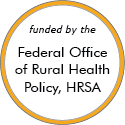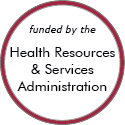Rural Project Examples: Health workforce education and training
Evidence-Based Examples
Thomas Jefferson University's Physician Shortage Area Program
Added March 2023
- Need: More rural doctors were needed in Pennsylvania, where nearly half of the state's physicians practice in just three large metropolitan counties.
- Intervention: Sidney Kimmel Medical College at Thomas Jefferson University established the Physician Shortage Area Program (PSAP) in 1974 to recruit and support students who are from rural backgrounds and who wish to practice in rural communities.
- Results: Approximately 80% of PSAP alumni have remained in rural family medicine for at least 20 to 25 years after graduation.
Effective Examples
Wyoming Trauma Telehealth Treatment Clinic
Updated/reviewed February 2024
- Need: To provide psychotherapy to survivors of domestic violence and sexual assault.
- Intervention: University of Wyoming psychology doctoral students provide psychotherapy via videoconferencing to crisis center clients in two rural locations.
- Results: Clients, student therapists, and crisis center staff were satisfied with the quality of services, and clients reported reduced symptoms of depression and PTSD.
OHSU Rural Surgery Training
Updated/reviewed October 2023
- Need: General surgeons are needed in rural communities.
- Intervention: Oregon Health & Science University (OHSU) is sending residents to complete a general surgery rotation in rural southern Oregon.
- Results: 39% of the graduates of the rural residency program are now practicing in a rural setting. The residents remain more likely than other OHSU residents to enter general surgery practice and to serve in a community of fewer than 50,000 people.
Rural Medical Education Program at University of Illinois College of Medicine Rockford
Added October 2023
- Need: To recruit and train medical students who are committed to choosing rural practice.
- Intervention: An add-on curriculum that includes seminars, field trips, and clinical rotations in rural and underserved areas.
- Results: 436 students have graduated from the RMED program between 1997 and 2023, with 65% of program graduates practicing in towns of less than 50,000 people.
MU AHEC Summer Community Program
Updated/reviewed September 2023
- Need: Lack of healthcare providers, specifically physicians, in rural Missouri.
- Intervention: Rising second-year medical students at University of Missouri's School of Medicine are given the opportunity to participate in a clinical program in a rural community setting.
- Results: Almost half of the participants from 1996-2010 chose to practice in rural locations upon graduation.
Livingston County Help For Seniors

Updated/reviewed May 2020
- Need: Meeting the health needs of geriatric patients in rural Livingston County, New York.
- Intervention: The Help for Seniors program was developed and using its 'vodcasts,' local EMTs were trained in geriatric screening methods and health needs treatment.
- Results: In addition to developing a successful model for educating EMS personnel, the program screened over 1200 individuals and identified various risks among the geriatric population.
Promising Examples
TUSM-MMC Program Longitudinal Integrated Clerkship

Updated/reviewed April 2024
- Need: To fill vacant medical positions in Maine's rural medical facilities.
- Intervention: The Tufts Maine Track LIC program offers clerkships in rural medical facilities, exposing medical school students to the positives and possibilities that rural practices have to offer.
- Results: The program has seen an increase in students' interest in practicing in rural Maine. The majority of participants have pursued medical careers in one of the six core specialties studied during their clerkship.
Other Project Examples
Targeted Rural Underserved Track (TRUST) Program

Updated/reviewed March 2024
- Need: There is a shortage of rural physicians in the Northwestern United States.
- Intervention: University of Washington medical students are receiving training through the TRUST program in rural, underserved communities across a five-state radius.
- Results: Long-lasting connections have been formed among regional and underserved communities, medical students, and rural health professionals, with the goal of producing more rural physicians.
Pacific AIDS Education and Training Center-Nevada

Updated/reviewed February 2024
- Need: To improve and increase prevention and care services for HIV, STDs, hepatitis C, and other infectious diseases.
- Intervention: PAETC-NV provides clinical and didactic trainings, conferences, technical assistance, capacity building, webinars, and other services to providers and healthcare organizations statewide.
- Results: In 2023, PAETC-NV trained more than 1,600 healthcare providers across Nevada to increase clinical capacity in the care, screening, and prevention of HIV, other sexually transmitted diseases, and hepatitis C.
Hawai'i Island Family Medicine Residency
Updated/reviewed January 2024
- Need: Hawai'i is experiencing a severe shortage of family medicine physicians.
- Intervention: The Hawai'i Island Family Medicine Residency (HIFMR) program uses an interprofessional team-based approach so residents learn how to care for many types of patients in different healthcare settings.
- Results: Since 2017, HIFMR has graduated a class of 3 to 6 Board-certified family medicine physicians annually. Most graduates have remained in the state to practice medicine; those who have left have entered fellowship programs and plan to return to Hawai'i Island to practice.
For examples from other sources, see:
